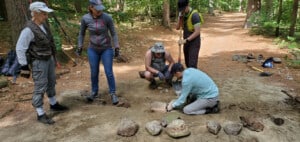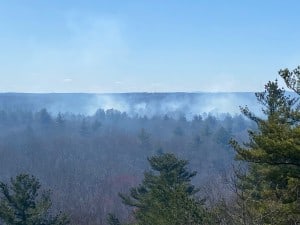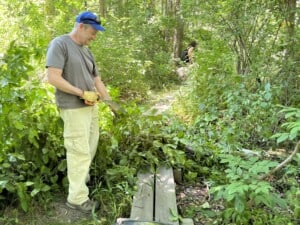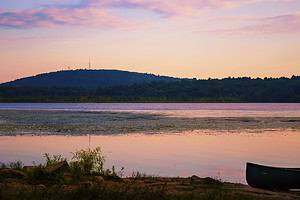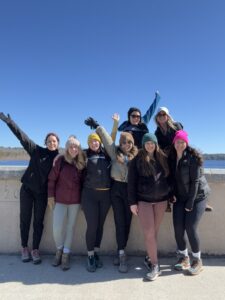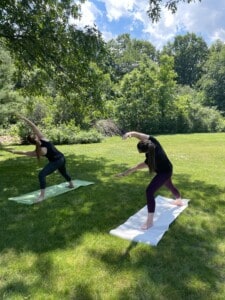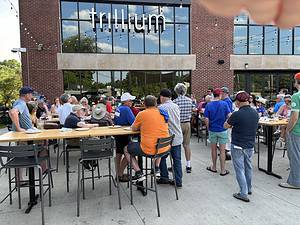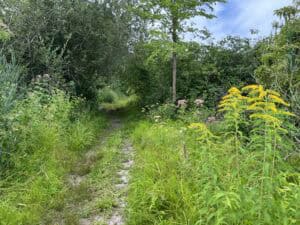Blue Hills A-Live interview with Les Tyrala
Judy Jacobs: Have you ever walked up Great Blue Hill from the Trailside Museum on the Red Dot trail? Have you ever thought about how unique it is? How Great Blue is the highest point around, and the rocks that you scramble up to get to the summit are pretty unique to southern New England?
Today you might get a different perspective on a place that might be very familiar to you.
I’m Judy Lehrer Jacobs, the executive director of the Friends of the Blue Hills, and I’m with Les Tyrala who is a registered geologist. We’ll be talking to you about some surprising history of Great Blue Hill. But before we get going, if you could just put in the comments whether you have ever gone up Great Blue that would be great (if you have ever visited). That would be wonderful.
This is the first of four Facebook live shows that we are calling Blue Hills A-Live. We’re going to be having them Tuesdays at 1 pm, so we hope you check in next Tuesday as well. If you have any questions, please just put questions in the comments below. That would be great.
Even if you’re watching the replay, Les would be happy to answer your questions in the next couple days. So as I said, we will be speaking with a geologist about a story of the origins of the Blue Hills that few people know. Les, thank you so much for joining us today. Can you start out by just giving us a sense of why you became interested in geology and why you’re so passionate about this.
Les Tyrala: Sure, Judy. Thanks for asking me here. Well, like many kids I was fascinated by bright shiny minerals, and fortunately or unfortunately that stayed with me into adulthood. Then I discovered I could actually have a career in geology and got a bachelor’s degree from the College Alliance in Arizona, did my graduate studies in Texas, and have worked at this as a job just for my whole career.
Judy: Oh, that’s great! Well I’m glad you’re here today. You have so much information about the Great Blue Hill that I’m sure people would be really interested in hearing. What is the one thing that you think people might not know about Great Blue Hill?
Les: Well based on my experience of having spent a lot of time here in the Blue Hills, few people realize that we’re walking across a large igneous body. In this case, it really is an extinct volcano is the way to think about it. It goes back several hundred million.
Judy: So why don’t you give us a sense of why—why this would be different, why the Blue Hills would be different, why a volcano would be here as opposed to like Salem or Plymouth?
Les: Yes. It’s perplexed geologists not only for the Blue Hills volcano but other volcanos that seem to be isolated (as this feature is) and it’s still debated. With the understanding of plate tectonics, this provides a mechanism for fracturing, moving, banging together continental masses. In this case, the North American plate and the European plate—and also the African plate. With this kind of dynamic aspect of the Earth, it allows for deep-seated movement of molten rock, and since the molten rock is of a lesser density than the overlying called bedrock (whatever it is), these molten bodies will move upward.
Judy: So can you give us a sense of how old the Blue Hill volcano is?
Les: Studies have been done to age-date it. Principally the most recent time, Professor Emeritus Jim Skehan of Boston College and Professor Emerita Meg Thompson of Wellesley College have had grant money to understand volcanism here right in our backyard. Their efforts have indicated that this particular feature is about 410 million years old. The age-dating is based on certain minerals that contain isotopes, particularly a mineral called zircon. It has a radioactive isotope in it called U 238. With geologic time, that degrades into lead. The half-life of zircon (this U 238 to lead) is almost 2.5 billion years. So with that kind of extreme half-life, we can accurately date the volcano and in fact go right back to the genesis of the Earth.
Judy: What was here before the volcano?
Les: Good question. It would have been, it’s been interpreted as, a level area. There were previous volcanic eruptions here, and it’s been named the Mattapan volcanic sequence. Where it is exposed in Mattapan, Quincy, and Milton, it’s basically flat-lying so it hasn’t been disturbed too much. There may have been some topography here where it was flowing downward and outward, but for the most part it appears to have been flowing out gently on a level surface. The conduit was probably fractures in the Earth rather than a true classic shield-type volcano.
Judy: Lava is not something we think about when we think of the Blue Hills. Can you give us a sense of what it is and why it would be different in the Blue Hills from other locations?
Les: Yes. There are four broad categories of magma, and it has to do with the geochemical makeup of it. We have rhyolite, which is here. It’s a very silica-rich lava, and then it grates compositionally into an andesite then a dacite and ultimately a floor rock referred to as basalt. Hingham has exposures of basalt, and the North Shore has exposures above andesite and dacite and we have rhyolite.
Judy: That’s great. If someone wanted to find lava in the Blue Hills, where would they go?
Les: Well, fortunately, we have lots of good exposure, and we can thank the glacial activity for having done that. Any trail going up to the meteorological observatory will be crossing the lava flows, which as I mentioned a moment ago, is called a rhyolite or in the older literature it’s referred to as a quartz-porphyry. If you’re doing some homework, you’ll see those two terms. It’s very well exposed on Red Dot path, and also at the very summit there are nice exposures there and also of the older Mattapan of volcanics, which are dated back in excess of 500 million years.
Judy: That’s great. Can you say where’s the top of the volcano?
Les: That’s a frequently asked question. The depth of erosion is so deep here—because we’re talking about in excess of 400 million years—that summit (wherever it was) was completely eroded away. So it’s a process of both natural erosion and glacial activity literally bulldozing and conveying away the rocks. So we don’t know that.
Judy: Great. And it looks like Kathie Edmunds Bendix, who gave us the name of this show Blue Hills A-Live, says she loved being in the area as a child in the 1950s (wow!) and the 60s. It’s so great to hear some of the great memories of the Blue Hills.
Is there anything else you want to share with us about the geologic history of Great Blue Hill?
Les: If you have gone walking on many of the other trails we have here, you have seen what is called the “giant conglomerate,” which is nicely exposed on Route 128. That conglomerate, which is sedimentary rock, is actually made up of weathered rock from the Blue Hills volcano. Through the process of deposition and turning that loose material into bedrock, we now have the giant conglomerate. It’s an impressive feature that tells us at one point there was a lot of kinetic energy here, meaning something like the Front Range of Colorado: lots of flowing water, moving large rocks, and turning them into rounded boulders. Lastly, if you are interested, Professor Jim Skehan of BC in 2001 put out a book Roadside Geology of Massachusetts. It’s meant for the nontechnical person. It’s a very good read, lots of figures, really well done, and I would suggest getting that at your library.
Judy: Well, thank you so much, Les. And thanks to all of you for watching our first Facebook live show. If you want to check in next Tuesday at 1 pm, we will be interviewing someone who has a lot of experience in long-distance running.
If you want more information about the Blue Hills, I encourage you to download a free guide to the Blue Hills at friendsofthebluehills.org/guide. And I hope that you go to visit Great Blue Hill and go with a new sense of all the amazing geological history that is in the Blue Hills.
Thanks so much for watching.

